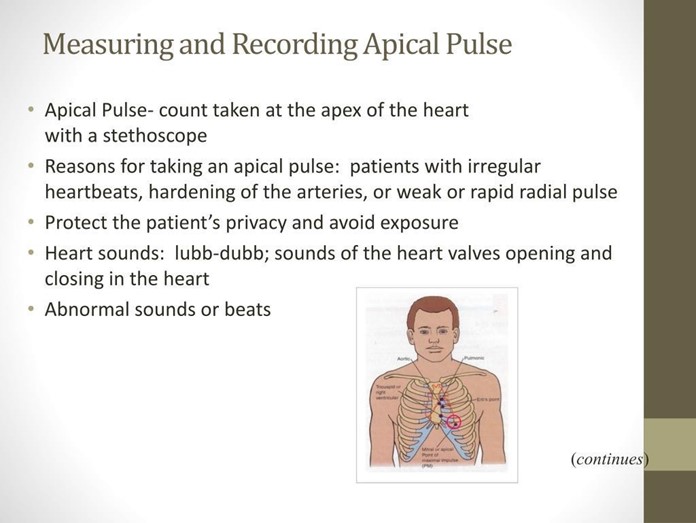While assessing the newborn, the nurse should be aware that the average expected apical pulse range of a full-term, quiet, alert newborn is __ beats/min.
100 to 120
120 to 160
80 to 100
150 to 180
The Correct Answer is B
Choice a) 100 to 120 is incorrect because this is too low for a normal newborn's heart rate. The heart rate of a newborn is influenced by factors such as gestational age, activity level, temperature, and health status. A full-term, quiet, alert newborn should have a heart rate between 120 and 160 beats per minute, which reflects their high metabolic rate and oxygen demand. A heart rate below 100 beats per minute may indicate bradycardia, which can be caused by hypoxia, hypothermia, or cardiac problems.
Choice b) 120 to 160 is correct because this is the normal range for a full-term, quiet, alert newborn's heart rate. The apical pulse is the best way to measure the heart rate of a newborn, as it reflects the actual contractions of the heart. The apical pulse can be auscultated at the fourth intercostal space on the left side of the chest, just below the nipple line. The nurse should count the apical pulse for a full minute, as it may vary with the respiratory cycle.
Choice c) 80 to 100 is incorrect because this is also too low for a normal newborn's heart rate. A full-term, quiet, alert newborn should have a heart rate between 120 and 160 beats per minute, which is higher than that of an adult or an older child. A heart rate below 100 beats per minute may indicate bradycardia, which can be caused by hypoxia, hypothermia, or cardiac problems.
Choice d) 150 to 180 is incorrect because this is too high for a normal newborn's heart rate. A full-term, quiet, alert newborn should have a heart rate between 120 and 160 beats per minute, which is lower than that of a preterm or a crying newborn. A heart rate above 160 beats per minute may indicate tachycardia, which can be caused by fever, infection, anemia, or hyperthyroidism.

Nursing Test Bank
Naxlex Comprehensive Predictor Exams
Related Questions
Correct Answer is B
Explanation
Choice A) Wrap the cord loosely with a sterile towel saturated with warm normal saline: This is not an appropriate action because it does not relieve the compression of the cord, which can cause fetal hypoxia and acidosis. The cord should be kept moist, but not wrapped around anything.
Choice B) Place a sterile gloved hand into the vagina and hold the presenting part off the cord while calling for assistance: This is the correct action because it prevents further descent of the fetus and reduces the pressure on the cord, which can improve fetal oxygenation and blood flow. The nurse should also elevate the woman's hips and place her in a knee-chest or Trendelenburg position to reduce gravity. The nurse should call for immediate assistance and prepare for an emergency cesarean section.
Choice C) Increase the IV drip rate: This is not an appropriate action because it does not address the cause of the variable decelerations, which is cord compression. Increasing the IV fluid may cause fluid overload and worsen maternal and fetal outcomes.
Choice D) Administer oxygen to the woman via mask at 8 to 10 L/minute: This is not an appropriate action because it does not relieve the cord compression, which is the main threat to fetal well-being. Oxygen administration may be helpful in some cases of fetal distress, but it is not sufficient in this situation.
Correct Answer is D
Explanation
Choice A: This is incorrect because both physiological and nonphysiological jaundice result from breakdown of erythrocytes. Jaundice is caused by the accumulation of bilirubin, a yellow pigment that is produced when red blood cells are destroyed. However, the rate and extent of hemolysis differ between the two types of jaundice.
Choice B: This is incorrect because kernicterus is a rare and serious complication of jaundice, not a usual outcome. Kernicterus occurs when bilirubin levels are very high and the pigment deposits in the brain, causing neurological damage. It can affect both physiological and nonphysiological jaundice, but it is more likely to occur in nonphysiological jaundice due to higher bilirubin levels and underlying conditions.
Choice C: This is incorrect because both physiological and nonphysiological jaundice begin at the head and progress down the body. This is because bilirubin accumulates in areas with high fat content, such as the skin, eyes, and brain. The distribution of jaundice depends on the level of bilirubin in the blood, not on the type of jaundice.
Choice D: This is the correct answer because nonphysiological jaundice appears in the first 24 hours of life, whereas physiological jaundice appears after the first 24 hours of life. Nonphysiological jaundice is caused by factors that increase hemolysis or impair bilirubin metabolism or excretion, such as blood group incompatibility, infection, liver disease, or enzyme deficiency. Physiological jaundice is caused by normal adaptation processes that occur after birth, such as increased red blood cell turnover, immature liver function, and delayed intestinal flora colonization.

Whether you are a student looking to ace your exams or a practicing nurse seeking to enhance your expertise , our nursing education contents will empower you with the confidence and competence to make a difference in the lives of patients and become a respected leader in the healthcare field.
Visit Naxlex, invest in your future and unlock endless possibilities with our unparalleled nursing education contents today
Report Wrong Answer on the Current Question
Do you disagree with the answer? If yes, what is your expected answer? Explain.
Kindly be descriptive with the issue you are facing.
